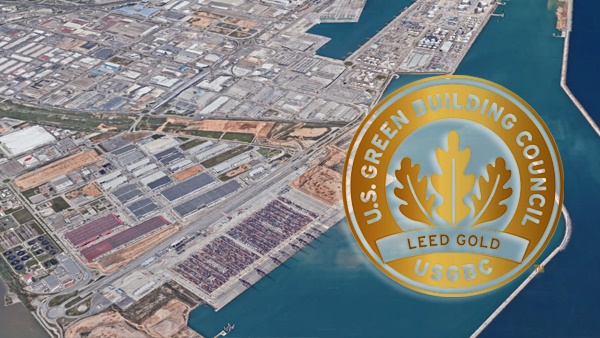- The construction of logistics warehouses in the ZAL Port is done under the strict standards of eco-efficiency and sustainability of the LEED certification given by the US Green Building Council.
- The commitment to LEED certification is one of the actions we develop to advance towards the Sustainable Development Goals established by the United Nations.
Logistics and construction activities are undergoing a transformation and will continue to do so in the long term for sustainable development. Aware of this and the importance of minimizing our ecological footprint and building a better world, at the ZAL Port we develop actions aimed at enhancing sustainability: reduction of irrigation water consumption, commitment to sustainable mobility, energy efficiency or reduction of CO2 emissions are just a few examples.
One of the most significant aspects of the actions carried out by CILSA -managing company of the ZAL Port- in favor of sustainable development is the certification of logistics warehouses according to LEED (Leadership in Energy & Environmental Design) standards. LEED is a building sustainability assessment and certification system given by the US Green Building Council. A tool to achieve levels of design, construction and operation of buildings, increasingly environmentally friendly and respectful with comfort and people’s health.
Although the LEED certificate is completely voluntary, for the ZAL Port it is an essential requirement for all new developments built since 2016. Up to now, 5 warehouses have obtained the LEED certificate, and specifically in the Gold category: Carrefour Frío (2017) , Fedex (2019), UPS (2020), ZAM (2020) and Caprabo (2021). Currently, another 2 warehouses are in the process of obtaining.
“From the planning of the logistical development of the ZAL Port we conduct actions aimed at enhancing the sustainability and care of the environment, being pioneers in good practices. The LEED Gold certifications that our warehouses receive satisfy us because they show how we assume this commitment, making it public with the aim of sharing our model as an example for the improvement of practices in our society and professional environment “says Marcos Vallés, Technical and Operations Director of the ZAL Port.
The aim of CILSA is to offer our customers the best logistics infrastructures in a reference location with the highest environmental standards. The LEED certificate of the warehouses and the environmental and energy management system that we have implemented enable us to be more competitive and offer our customers logistics infrastructures with great added value.
Criteria and benefits of the LEED certificate
LEED is based on scientific standards and evaluates all the building’s construction processes, from the adequacy of the plot where it is located, to the efficiency of the use of water and energy, the selection of sustainable materials or the interior environmental quality. The LEED objective is to reduce the environmental impact of buildings by considering their entire life cycle, from construction to use.
LEED certification is a third-party validation of a building’s performance. The environmental vectors that are analysed and evaluated are: integrated process, location and transport, sustainable location, efficient use of water, energy and atmosphere, materials and resources, interior environmental quality, innovation and design process and regional priority.
The benefits resulting from this certificate are multiple for the owner or the occupant:
- The operating costs are lower, while the value of the property increases.
- The waste sent to landfills is reduced.
- Better energy and water conservation.
- Healthier and safer buildings for their occupants.
- Reduction of the emission of harmful greenhouse gases into the atmosphere.
In conclusion, beneficial standards for the environment and for the customers that enable us to continue advancing to achieve the Sustainable Development Goals established by the United Nations.
 [+34] 93 552 58 26
[+34] 93 552 58 26 sac@zalport.com
sac@zalport.com Av. Ports d'Europa 100, Planta 0, 08040. Barcelona
Av. Ports d'Europa 100, Planta 0, 08040. Barcelona






